Three top trading tips that could transform your results
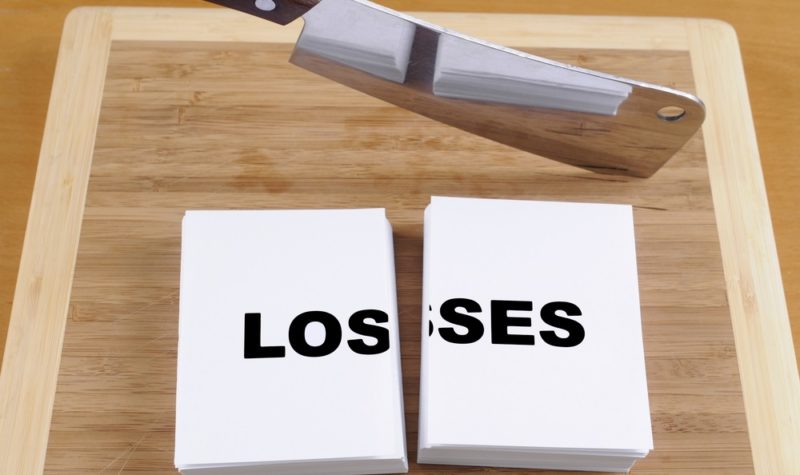
Veteran trader David Jones reveals his top three tips to avoid the mistakes that most first-time traders make.
It is rapidly approaching that time of year where we all like to indulge in a spot of navel-gazing and reflect on the year that went by – and what we might have done differently, if we could run it all over again. Clearly 2020 has been a year like not many others, to say the least. Financial markets have been a sideshow to the main event of the Covid-19 pandemic, but it has also been an exceptional year in the world of trading as well. But one thing that never changes every year is that most traders lose. If you are in that category, then hopefully these tips and real examples might help nudge you back on the right track.
1. Busier does not mean better
2020 has seen a shift in working patterns for at least some of the world’s workers. No more long commutes, no more eight hours sat in front of a screen, or eight hours stuck in meetings about meetings. If you have been fortunate enough to work from home then, just perhaps, you’ve had a slightly less frantic working week – but still managed to get the job done as before. I think there is a good comparison with trading to be made here.
To someone with much better things to do than watch markets all day, the common misconception would be that trading is all about doing just that – being stuck in front of a screen studying every minute-by-minute move in your chosen market(s). Of course, some do exactly this – but I really don’t believe that time spent watching stuff going up and down has a direct relation to whether or not you are profitable. You do not need to be in and out of the market every day, every week or even every month to be a profitable trader. We could all do ourselves a favour by taking a step back and focusing on the bigger picture.
Dow Jones Index – year to date 2020
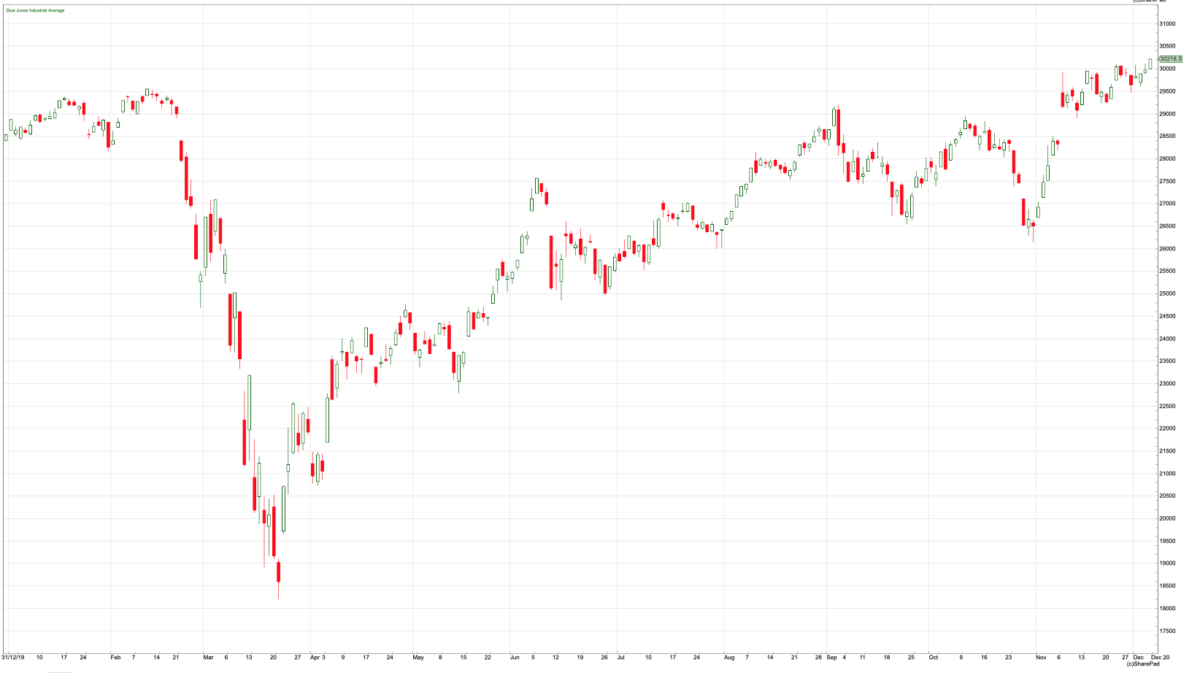
Given of the sort of year we have just been through, there are plenty of markets I could have chosen to illustrate this point – but the Dow Jones index seems appropriate enough as one that lots of us will be familiar with. If we look at the recovery the market is (still) in, it started on 23rd March after making a low of 18,200. At the time of writing, it is above 30,000. You could have traded it every day over the past nine months, attempting to call every twist and turn in this popular stock index. But if you had not got around to trading it until the summer, there was still a good 15% yet to come.
I am trying to make a couple of points here. Firstly, you do not need to be in on the exact turning point for a market – very few are, of course. There are often still plenty of opportunities to try and profit even if you are in much later. And secondly, the larger profits are made in the bigger swing. Just because many people think that trading is all about buying and selling every few minutes – you do not have to do it that way. There is no need to be a busy fool.
Sugar – year to date 2020
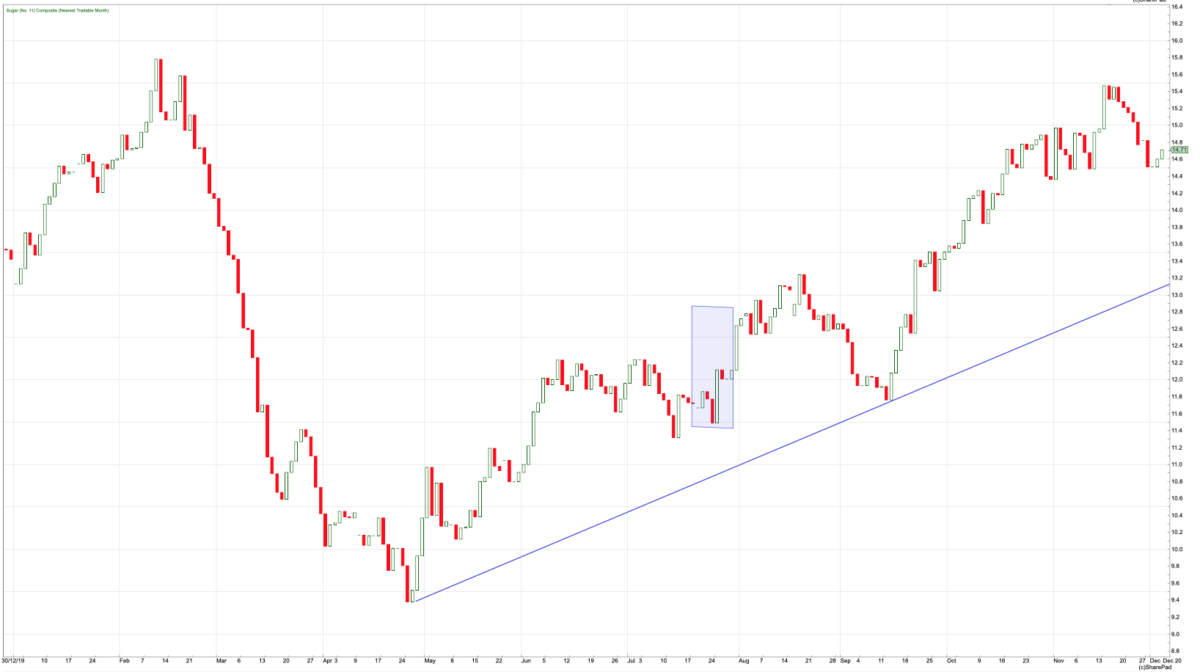
One of my more profitable trades this year has been sugar – not a market that tends to be talked about very often in most of the financial media. Nevertheless, like any market it is an interesting one – but it was a good few months after the bottom in April that I put the trade on, which I have highlighted with the rectangle on the chart (and at the time of writing, it is still running). It’s another example of the two points above in relation to the Dow. You do not need to be the first in on a market turn, and the larger profits are made in the bigger moves, so be patient.
2. Manage Risk
I do have a tendency to bang on about this in my monthly columns – but I make no excuses for making the point! Trading is all about risk. We are taking on additional risk compared to leaving our cash on deposit to try to make greater returns. When it goes wrong, we need to manage that risk and usually take the pre-planned loss.
The reality is too many people do not, and this is why most traders will lose – more than 70% of participants typically, according to spread bet brokers’ risk warnings. The typical pattern for far too many is a run of small profits – and then a trade that starts to go the opposite way to what was expected. It is human nature to have a problem admitting when we are wrong – but that is not much help in financial trading. Our trader sticks their head in the sand, the loss gets bigger and bigger, wiping out the previous profits. Our trader now has to deliver a Herculean effort just to get back to break-even. This is not sensible management of risk!
The lesson here is to know where you are going to get out before you get in – and stick to it. Another example follows from my trading year.
Gold – year to date 2020
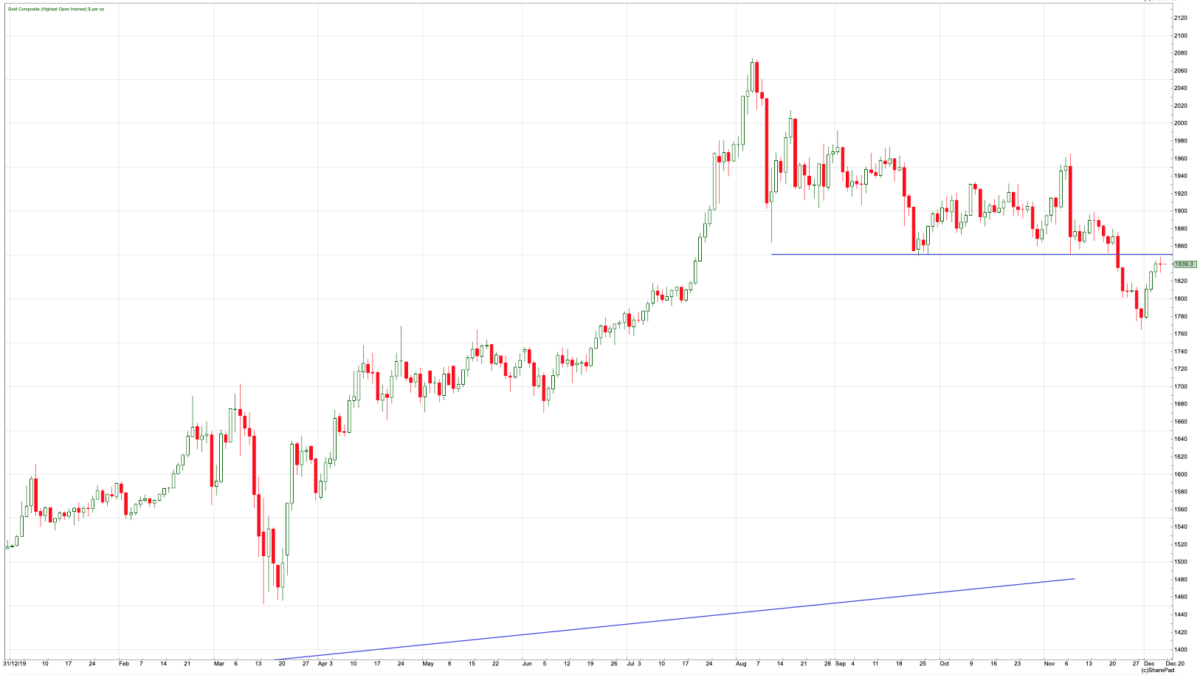
It has been something of a banner year for gold – the precious metal hit a fresh all-time high in August, trading up to $2,075 an ounce. It had been almost nine years since traders last saw gold hit new heights.
Like all good trend followers, I treated the corresponding sell-off after this as just a correction in the overall upwards trend and a buying opportunity. But it wasn’t to be and I ended up getting stopped out for a loss, as gold moved back to a four-month low in November. But I had a plan for taking an acceptable risk, the loss was manageable – time to move on to another idea. In my experience, it is poor risk management that is the downfall of most traders – particularly the new ones. I am actually being over generous even with that statement. Most people have no risk management whatsoever and don’t even countenance that their trading idea might turn out to be wrong. Don’t make this amateur mistake.
3. Risk versus reward – and the importance of running profits
The reason most traders lose overall is that their profits are smaller than their losses. Typically, the losing trader is not wrong all the time. But when they are right, they may make £100 profit – but lose £200 when wrong. It is important to take trades where the upside is potentially much more than the downside. And when the trade is running in your favour, DO NOT be tempted to exit early and snatch at profits – or you will be joining the ranks of the losers.
Another real-world example follows. I have traded EUR/USD a few times this year and at the time of writing, after some frustrating months, that patience is finally starting to pay off at last.
EUR/USD – year to date 2020
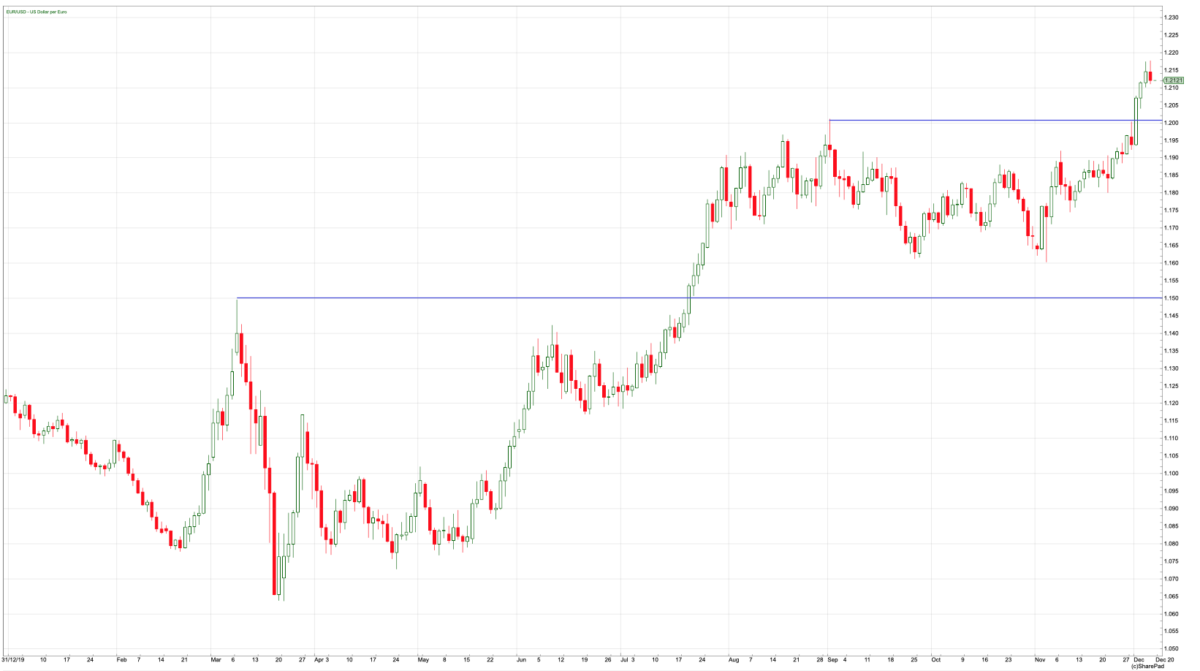
We have seen a turnaround in the fortunes of the euro this year after it traded down near a three-year low in March. Since then, the price has rallied, moving out to fresh highs for the year in July. I bought into this momentum and added another position during the summer. But then the momentum stopped – and it went nowhere. Although the first trade was showing a profit, it was only slightly more than the risk I had allowed when I opened the trade, so there was no point in snatching at it. September, October and November saw EUR/USD stuck in a wide sideways range – very boring, and not delivering any additional profit.
But as December got underway, finally the euro started to move again, trading up to its best levels since April 2018. The next leg higher for the euro could well be underway, so I am glad I was patient, stuck with the position and waited to see if I could run the profit further. I do think this could well be one of the interesting markets to watch in the year ahead and for now at least, from a technical perspective, I would be happy to be a buyer on dips.
Conclusions
On the face of it, trading is not hard. We want to buy low and sell higher – or vice versa of course when short-selling. But so many people struggle to turn a profit. I don’t consider myself an out-and-out expert on the subject – I think there is always more to learn. But in the two decades I have been trading, and talking to thousands of others who have started, I think the big mistake many make is to trade too much, ignore risk management, and snatch at profits whilst having a more relaxed approach to letting running losses increase.
There is no silver bullet to trading success, but I hope the three points outlined in some depth here help you become a better trader in 2021.
Comments (0)